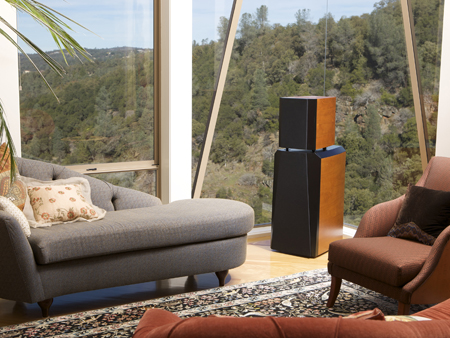Four-Way Floorstanding Listening System for Audiophiles; Uncompromising Speaker Emphasizes Performance, Accuracy and Power
Pass Laboratories, Inc., an audio innovator renowned for its unique high-performance products, exhibits the SR1 Loudspeaker, a high-performance listening system using the highest quality drivers available, at the 2009 International Consumer Electronics Show.
Pass Labs’ SR1 Speaker Features Premium Furniture-Grade Cabinetry
The new SR1 is Pass Labs’ second loudspeaker, following and replacing the Rushmore, its dynamic introductory model. The SR1, a four-way floorstanding system, is equally uncompromising. Its highly refined sound stage, deep awareness of micro-detail, and effortless dynamics deliver superb, accurate musical reproduction.
Each SR1 consists of four independently adjustable amplification packages plus a four-way active electronic crossover integrated with four highly efficient speaker drivers. Like the Rushmore, the SR1 leverages the ability of dedicated, active electronics to enhance and complement the performance of its passive components. More than the Rushmore, the SR1 emphasizes absolute audio performance over driver sensitivity, and offers more flexibility in selecting complementary power amplifiers and crossovers, which can range from totally passive to active quad-amplification.
The SR1 has been designed to harness the classic “mass controlled piston” model, in which the speaker’s radiating surface behaves as a rigid surface. This yields a well-defined characteristic in the spectral region where the sound is proportional to the electrical current through the voice coil. At the boundaries of this frequency band, the response falls off in a predictable manner.
The trick is to find a perfect piston driver. The cone surface must maintain its shape over the frequency band without breaking up into resonant vibrational modes. The suspension and motor system must remain linear with high excursion. But most speakers allow the cone to flex in a way that gives some extension at higher frequencies at the cost of an irregular response in the frequency response and phase performance.
The SR1’s drivers are the best available — Nextel-coated cones and a Crescendo tweeter from the renowned Seas of Norway. They present the best combination of low distortion, high dynamics, and predictable performance. It takes a minimum of four sizes of these drivers to span the SR1’s 10-octave audio range without significantly leaving the “piston” region.
The SR1 uses dual enclosures. A large bass enclosure with ten-inch and eight-inch drivers handles the bottom four octaves, and an adjustable smaller enclosure carries the midrange and the tweeter. The Seas drivers are complemented by a set of crossover and equalization electronics created to elicit the drivers’ best performance.

Pass Labs’ SR1, as Spectacular as its Setting
The SR1 Loudspeaker is available now from authorized Pass Labs dealers at a suggested price of $25,000/pair. It can be seen with Pass Labs’ other outstanding products in Suite 29-140, The Venetian Tower, during the show.
About Pass Labs
Founded in 1991 by legendary audio designer Nelson Pass, Pass Laboratories, Inc. markets its unique amplifiers, preamplifiers and speakers throughout the world. The company has been based in Foresthill, California, since its beginning, and is widely regarded as one of the most innovative audio brands in the world. Its critically acclaimed Aleph, X and XA-Series products have won numerous awards, and Founder Nelson Pass holds numerous audio patents. His achievements include developing the first dynamically biased Class A amplifier circuit, developing a fully cascode audio power amplifier, and developing the Stasis amplifier in 1977. He helped popularize solid-state, single-ended Class A power amplifiers, and developed the very successful Aleph series of products, and the Super-Symmetry™ circuit, which achieves exceptionally low distortion and noise levels. The company is now poised to introduce a new generation of amplifiers and other high-performance audio products.


























